Effectiveness for Coping Strategies
VerifiedAdded on 2023/06/11
|11
|3544
|102
AI Summary
This article discusses the prevalence and extent of cyberbullying among young adults, coping strategies used, and their effectiveness. It also explores the similarity between cyberbullying and traditional bullying, research problem, objectives, methodology, and analysis.
Contribute Materials
Your contribution can guide someone’s learning journey. Share your
documents today.
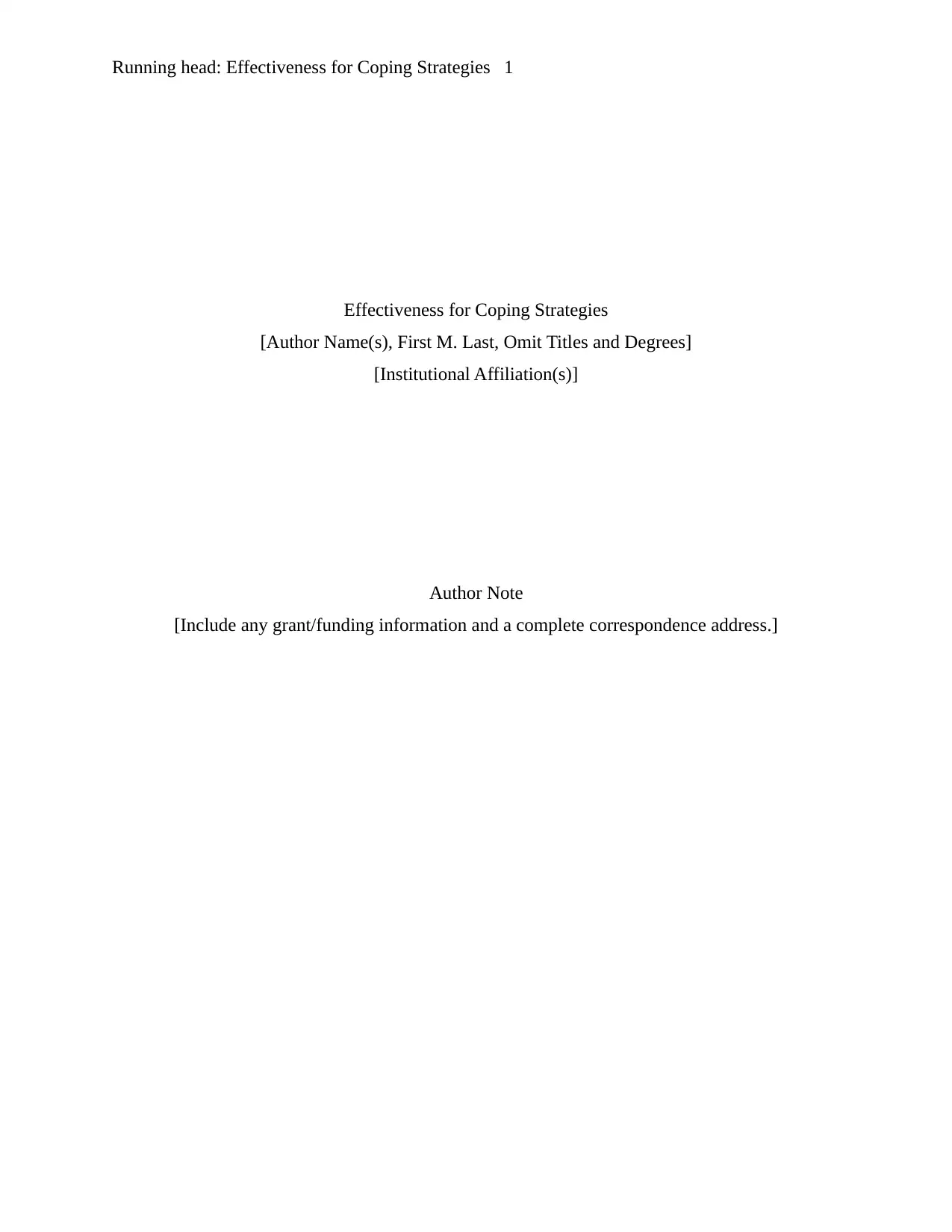
Running head: Effectiveness for Coping Strategies 1
Effectiveness for Coping Strategies
[Author Name(s), First M. Last, Omit Titles and Degrees]
[Institutional Affiliation(s)]
Author Note
[Include any grant/funding information and a complete correspondence address.]
Effectiveness for Coping Strategies
[Author Name(s), First M. Last, Omit Titles and Degrees]
[Institutional Affiliation(s)]
Author Note
[Include any grant/funding information and a complete correspondence address.]
Secure Best Marks with AI Grader
Need help grading? Try our AI Grader for instant feedback on your assignments.
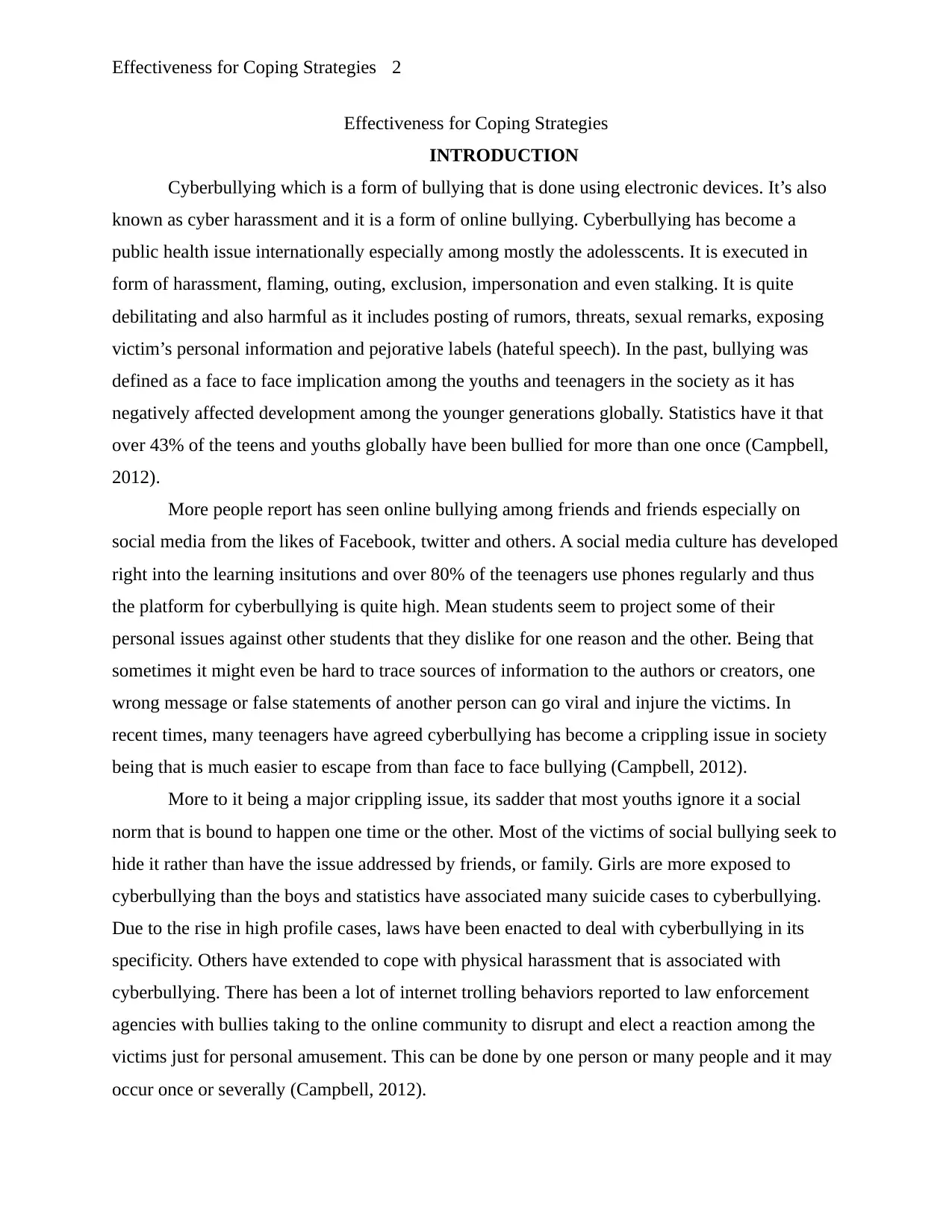
Effectiveness for Coping Strategies 2
Effectiveness for Coping Strategies
INTRODUCTION
Cyberbullying which is a form of bullying that is done using electronic devices. It’s also
known as cyber harassment and it is a form of online bullying. Cyberbullying has become a
public health issue internationally especially among mostly the adolesscents. It is executed in
form of harassment, flaming, outing, exclusion, impersonation and even stalking. It is quite
debilitating and also harmful as it includes posting of rumors, threats, sexual remarks, exposing
victim’s personal information and pejorative labels (hateful speech). In the past, bullying was
defined as a face to face implication among the youths and teenagers in the society as it has
negatively affected development among the younger generations globally. Statistics have it that
over 43% of the teens and youths globally have been bullied for more than one once (Campbell,
2012).
More people report has seen online bullying among friends and friends especially on
social media from the likes of Facebook, twitter and others. A social media culture has developed
right into the learning insitutions and over 80% of the teenagers use phones regularly and thus
the platform for cyberbullying is quite high. Mean students seem to project some of their
personal issues against other students that they dislike for one reason and the other. Being that
sometimes it might even be hard to trace sources of information to the authors or creators, one
wrong message or false statements of another person can go viral and injure the victims. In
recent times, many teenagers have agreed cyberbullying has become a crippling issue in society
being that is much easier to escape from than face to face bullying (Campbell, 2012).
More to it being a major crippling issue, its sadder that most youths ignore it a social
norm that is bound to happen one time or the other. Most of the victims of social bullying seek to
hide it rather than have the issue addressed by friends, or family. Girls are more exposed to
cyberbullying than the boys and statistics have associated many suicide cases to cyberbullying.
Due to the rise in high profile cases, laws have been enacted to deal with cyberbullying in its
specificity. Others have extended to cope with physical harassment that is associated with
cyberbullying. There has been a lot of internet trolling behaviors reported to law enforcement
agencies with bullies taking to the online community to disrupt and elect a reaction among the
victims just for personal amusement. This can be done by one person or many people and it may
occur once or severally (Campbell, 2012).
Effectiveness for Coping Strategies
INTRODUCTION
Cyberbullying which is a form of bullying that is done using electronic devices. It’s also
known as cyber harassment and it is a form of online bullying. Cyberbullying has become a
public health issue internationally especially among mostly the adolesscents. It is executed in
form of harassment, flaming, outing, exclusion, impersonation and even stalking. It is quite
debilitating and also harmful as it includes posting of rumors, threats, sexual remarks, exposing
victim’s personal information and pejorative labels (hateful speech). In the past, bullying was
defined as a face to face implication among the youths and teenagers in the society as it has
negatively affected development among the younger generations globally. Statistics have it that
over 43% of the teens and youths globally have been bullied for more than one once (Campbell,
2012).
More people report has seen online bullying among friends and friends especially on
social media from the likes of Facebook, twitter and others. A social media culture has developed
right into the learning insitutions and over 80% of the teenagers use phones regularly and thus
the platform for cyberbullying is quite high. Mean students seem to project some of their
personal issues against other students that they dislike for one reason and the other. Being that
sometimes it might even be hard to trace sources of information to the authors or creators, one
wrong message or false statements of another person can go viral and injure the victims. In
recent times, many teenagers have agreed cyberbullying has become a crippling issue in society
being that is much easier to escape from than face to face bullying (Campbell, 2012).
More to it being a major crippling issue, its sadder that most youths ignore it a social
norm that is bound to happen one time or the other. Most of the victims of social bullying seek to
hide it rather than have the issue addressed by friends, or family. Girls are more exposed to
cyberbullying than the boys and statistics have associated many suicide cases to cyberbullying.
Due to the rise in high profile cases, laws have been enacted to deal with cyberbullying in its
specificity. Others have extended to cope with physical harassment that is associated with
cyberbullying. There has been a lot of internet trolling behaviors reported to law enforcement
agencies with bullies taking to the online community to disrupt and elect a reaction among the
victims just for personal amusement. This can be done by one person or many people and it may
occur once or severally (Campbell, 2012).
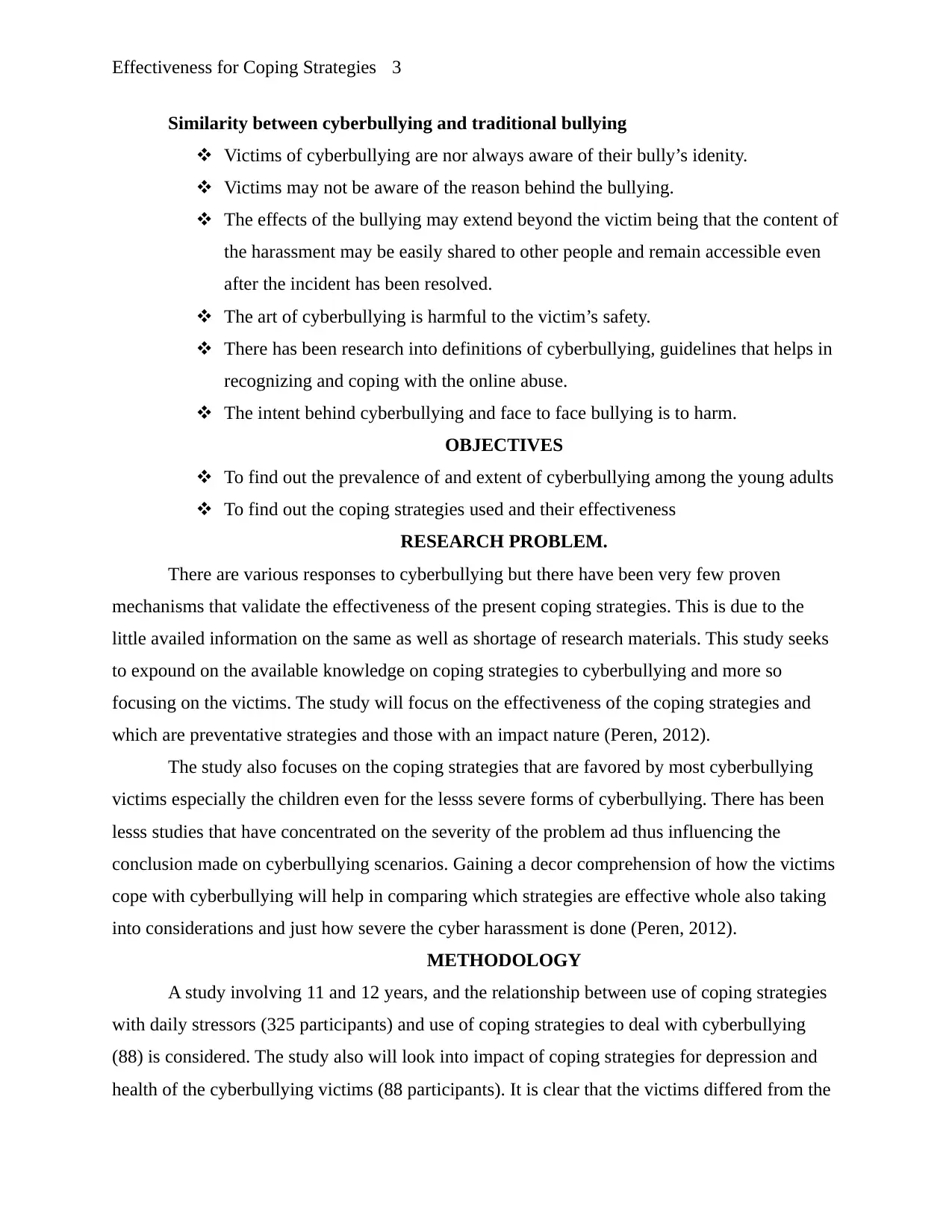
Effectiveness for Coping Strategies 3
Similarity between cyberbullying and traditional bullying
Victims of cyberbullying are nor always aware of their bully’s idenity.
Victims may not be aware of the reason behind the bullying.
The effects of the bullying may extend beyond the victim being that the content of
the harassment may be easily shared to other people and remain accessible even
after the incident has been resolved.
The art of cyberbullying is harmful to the victim’s safety.
There has been research into definitions of cyberbullying, guidelines that helps in
recognizing and coping with the online abuse.
The intent behind cyberbullying and face to face bullying is to harm.
OBJECTIVES
To find out the prevalence of and extent of cyberbullying among the young adults
To find out the coping strategies used and their effectiveness
RESEARCH PROBLEM.
There are various responses to cyberbullying but there have been very few proven
mechanisms that validate the effectiveness of the present coping strategies. This is due to the
little availed information on the same as well as shortage of research materials. This study seeks
to expound on the available knowledge on coping strategies to cyberbullying and more so
focusing on the victims. The study will focus on the effectiveness of the coping strategies and
which are preventative strategies and those with an impact nature (Peren, 2012).
The study also focuses on the coping strategies that are favored by most cyberbullying
victims especially the children even for the lesss severe forms of cyberbullying. There has been
lesss studies that have concentrated on the severity of the problem ad thus influencing the
conclusion made on cyberbullying scenarios. Gaining a decor comprehension of how the victims
cope with cyberbullying will help in comparing which strategies are effective whole also taking
into considerations and just how severe the cyber harassment is done (Peren, 2012).
METHODOLOGY
A study involving 11 and 12 years, and the relationship between use of coping strategies
with daily stressors (325 participants) and use of coping strategies to deal with cyberbullying
(88) is considered. The study also will look into impact of coping strategies for depression and
health of the cyberbullying victims (88 participants). It is clear that the victims differed from the
Similarity between cyberbullying and traditional bullying
Victims of cyberbullying are nor always aware of their bully’s idenity.
Victims may not be aware of the reason behind the bullying.
The effects of the bullying may extend beyond the victim being that the content of
the harassment may be easily shared to other people and remain accessible even
after the incident has been resolved.
The art of cyberbullying is harmful to the victim’s safety.
There has been research into definitions of cyberbullying, guidelines that helps in
recognizing and coping with the online abuse.
The intent behind cyberbullying and face to face bullying is to harm.
OBJECTIVES
To find out the prevalence of and extent of cyberbullying among the young adults
To find out the coping strategies used and their effectiveness
RESEARCH PROBLEM.
There are various responses to cyberbullying but there have been very few proven
mechanisms that validate the effectiveness of the present coping strategies. This is due to the
little availed information on the same as well as shortage of research materials. This study seeks
to expound on the available knowledge on coping strategies to cyberbullying and more so
focusing on the victims. The study will focus on the effectiveness of the coping strategies and
which are preventative strategies and those with an impact nature (Peren, 2012).
The study also focuses on the coping strategies that are favored by most cyberbullying
victims especially the children even for the lesss severe forms of cyberbullying. There has been
lesss studies that have concentrated on the severity of the problem ad thus influencing the
conclusion made on cyberbullying scenarios. Gaining a decor comprehension of how the victims
cope with cyberbullying will help in comparing which strategies are effective whole also taking
into considerations and just how severe the cyber harassment is done (Peren, 2012).
METHODOLOGY
A study involving 11 and 12 years, and the relationship between use of coping strategies
with daily stressors (325 participants) and use of coping strategies to deal with cyberbullying
(88) is considered. The study also will look into impact of coping strategies for depression and
health of the cyberbullying victims (88 participants). It is clear that the victims differed from the
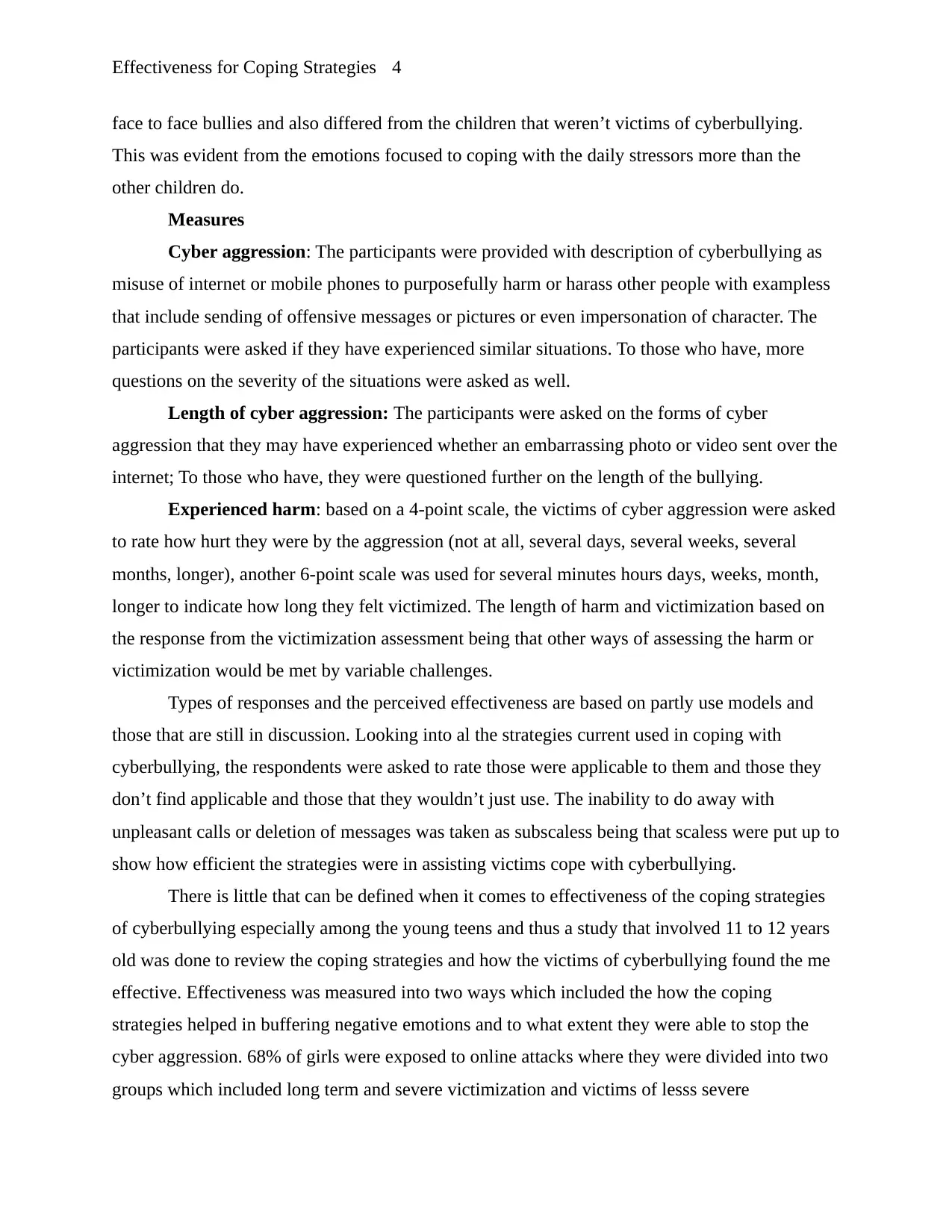
Effectiveness for Coping Strategies 4
face to face bullies and also differed from the children that weren’t victims of cyberbullying.
This was evident from the emotions focused to coping with the daily stressors more than the
other children do.
Measures
Cyber aggression: The participants were provided with description of cyberbullying as
misuse of internet or mobile phones to purposefully harm or harass other people with exampless
that include sending of offensive messages or pictures or even impersonation of character. The
participants were asked if they have experienced similar situations. To those who have, more
questions on the severity of the situations were asked as well.
Length of cyber aggression: The participants were asked on the forms of cyber
aggression that they may have experienced whether an embarrassing photo or video sent over the
internet; To those who have, they were questioned further on the length of the bullying.
Experienced harm: based on a 4-point scale, the victims of cyber aggression were asked
to rate how hurt they were by the aggression (not at all, several days, several weeks, several
months, longer), another 6-point scale was used for several minutes hours days, weeks, month,
longer to indicate how long they felt victimized. The length of harm and victimization based on
the response from the victimization assessment being that other ways of assessing the harm or
victimization would be met by variable challenges.
Types of responses and the perceived effectiveness are based on partly use models and
those that are still in discussion. Looking into al the strategies current used in coping with
cyberbullying, the respondents were asked to rate those were applicable to them and those they
don’t find applicable and those that they wouldn’t just use. The inability to do away with
unpleasant calls or deletion of messages was taken as subscaless being that scaless were put up to
show how efficient the strategies were in assisting victims cope with cyberbullying.
There is little that can be defined when it comes to effectiveness of the coping strategies
of cyberbullying especially among the young teens and thus a study that involved 11 to 12 years
old was done to review the coping strategies and how the victims of cyberbullying found the me
effective. Effectiveness was measured into two ways which included the how the coping
strategies helped in buffering negative emotions and to what extent they were able to stop the
cyber aggression. 68% of girls were exposed to online attacks where they were divided into two
groups which included long term and severe victimization and victims of lesss severe
face to face bullies and also differed from the children that weren’t victims of cyberbullying.
This was evident from the emotions focused to coping with the daily stressors more than the
other children do.
Measures
Cyber aggression: The participants were provided with description of cyberbullying as
misuse of internet or mobile phones to purposefully harm or harass other people with exampless
that include sending of offensive messages or pictures or even impersonation of character. The
participants were asked if they have experienced similar situations. To those who have, more
questions on the severity of the situations were asked as well.
Length of cyber aggression: The participants were asked on the forms of cyber
aggression that they may have experienced whether an embarrassing photo or video sent over the
internet; To those who have, they were questioned further on the length of the bullying.
Experienced harm: based on a 4-point scale, the victims of cyber aggression were asked
to rate how hurt they were by the aggression (not at all, several days, several weeks, several
months, longer), another 6-point scale was used for several minutes hours days, weeks, month,
longer to indicate how long they felt victimized. The length of harm and victimization based on
the response from the victimization assessment being that other ways of assessing the harm or
victimization would be met by variable challenges.
Types of responses and the perceived effectiveness are based on partly use models and
those that are still in discussion. Looking into al the strategies current used in coping with
cyberbullying, the respondents were asked to rate those were applicable to them and those they
don’t find applicable and those that they wouldn’t just use. The inability to do away with
unpleasant calls or deletion of messages was taken as subscaless being that scaless were put up to
show how efficient the strategies were in assisting victims cope with cyberbullying.
There is little that can be defined when it comes to effectiveness of the coping strategies
of cyberbullying especially among the young teens and thus a study that involved 11 to 12 years
old was done to review the coping strategies and how the victims of cyberbullying found the me
effective. Effectiveness was measured into two ways which included the how the coping
strategies helped in buffering negative emotions and to what extent they were able to stop the
cyber aggression. 68% of girls were exposed to online attacks where they were divided into two
groups which included long term and severe victimization and victims of lesss severe
Secure Best Marks with AI Grader
Need help grading? Try our AI Grader for instant feedback on your assignments.
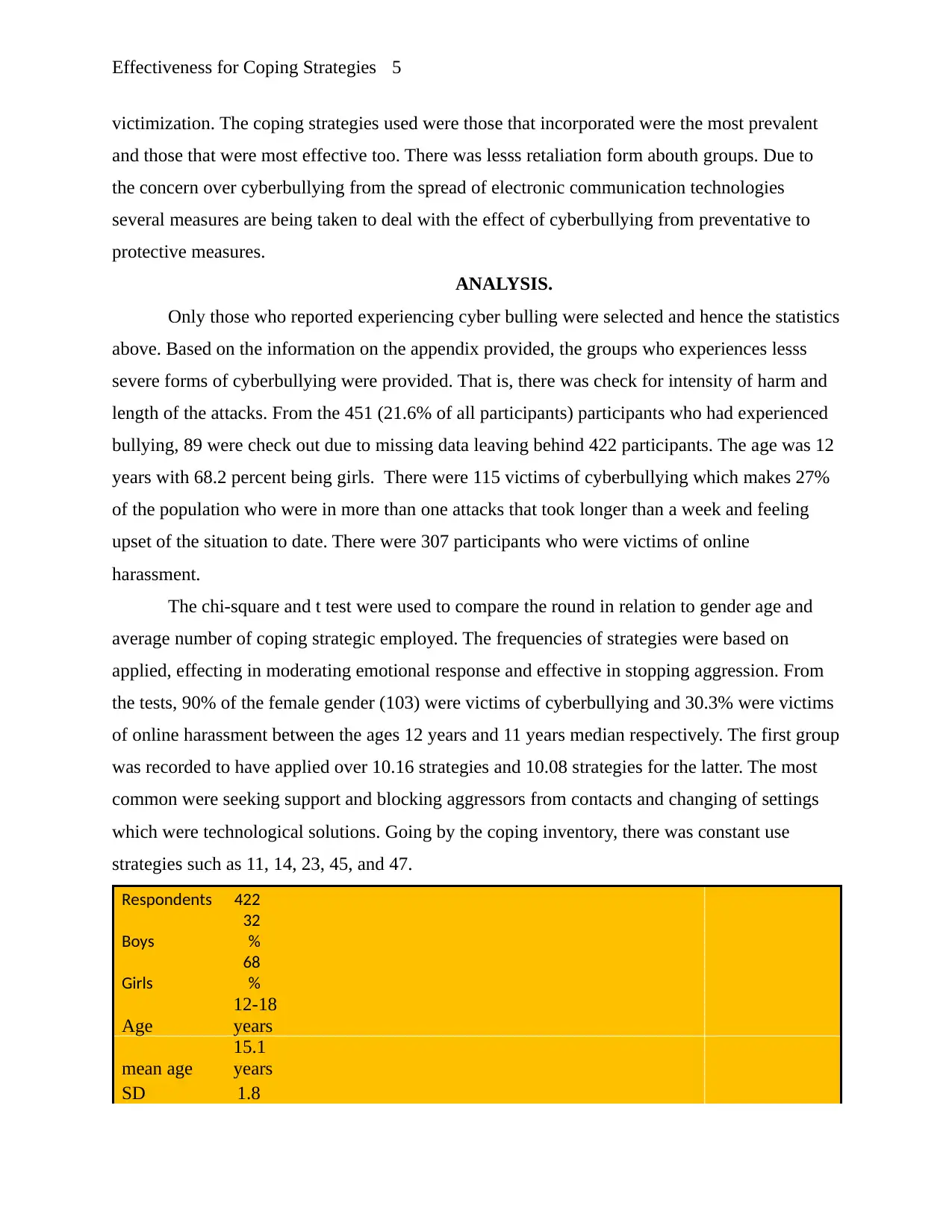
Effectiveness for Coping Strategies 5
victimization. The coping strategies used were those that incorporated were the most prevalent
and those that were most effective too. There was lesss retaliation form abouth groups. Due to
the concern over cyberbullying from the spread of electronic communication technologies
several measures are being taken to deal with the effect of cyberbullying from preventative to
protective measures.
ANALYSIS.
Only those who reported experiencing cyber bulling were selected and hence the statistics
above. Based on the information on the appendix provided, the groups who experiences lesss
severe forms of cyberbullying were provided. That is, there was check for intensity of harm and
length of the attacks. From the 451 (21.6% of all participants) participants who had experienced
bullying, 89 were check out due to missing data leaving behind 422 participants. The age was 12
years with 68.2 percent being girls. There were 115 victims of cyberbullying which makes 27%
of the population who were in more than one attacks that took longer than a week and feeling
upset of the situation to date. There were 307 participants who were victims of online
harassment.
The chi-square and t test were used to compare the round in relation to gender age and
average number of coping strategic employed. The frequencies of strategies were based on
applied, effecting in moderating emotional response and effective in stopping aggression. From
the tests, 90% of the female gender (103) were victims of cyberbullying and 30.3% were victims
of online harassment between the ages 12 years and 11 years median respectively. The first group
was recorded to have applied over 10.16 strategies and 10.08 strategies for the latter. The most
common were seeking support and blocking aggressors from contacts and changing of settings
which were technological solutions. Going by the coping inventory, there was constant use
strategies such as 11, 14, 23, 45, and 47.
Respondents 422
Boys
32
%
Girls
68
%
Age
12-18
years
mean age
15.1
years
SD 1.8
victimization. The coping strategies used were those that incorporated were the most prevalent
and those that were most effective too. There was lesss retaliation form abouth groups. Due to
the concern over cyberbullying from the spread of electronic communication technologies
several measures are being taken to deal with the effect of cyberbullying from preventative to
protective measures.
ANALYSIS.
Only those who reported experiencing cyber bulling were selected and hence the statistics
above. Based on the information on the appendix provided, the groups who experiences lesss
severe forms of cyberbullying were provided. That is, there was check for intensity of harm and
length of the attacks. From the 451 (21.6% of all participants) participants who had experienced
bullying, 89 were check out due to missing data leaving behind 422 participants. The age was 12
years with 68.2 percent being girls. There were 115 victims of cyberbullying which makes 27%
of the population who were in more than one attacks that took longer than a week and feeling
upset of the situation to date. There were 307 participants who were victims of online
harassment.
The chi-square and t test were used to compare the round in relation to gender age and
average number of coping strategic employed. The frequencies of strategies were based on
applied, effecting in moderating emotional response and effective in stopping aggression. From
the tests, 90% of the female gender (103) were victims of cyberbullying and 30.3% were victims
of online harassment between the ages 12 years and 11 years median respectively. The first group
was recorded to have applied over 10.16 strategies and 10.08 strategies for the latter. The most
common were seeking support and blocking aggressors from contacts and changing of settings
which were technological solutions. Going by the coping inventory, there was constant use
strategies such as 11, 14, 23, 45, and 47.
Respondents 422
Boys
32
%
Girls
68
%
Age
12-18
years
mean age
15.1
years
SD 1.8
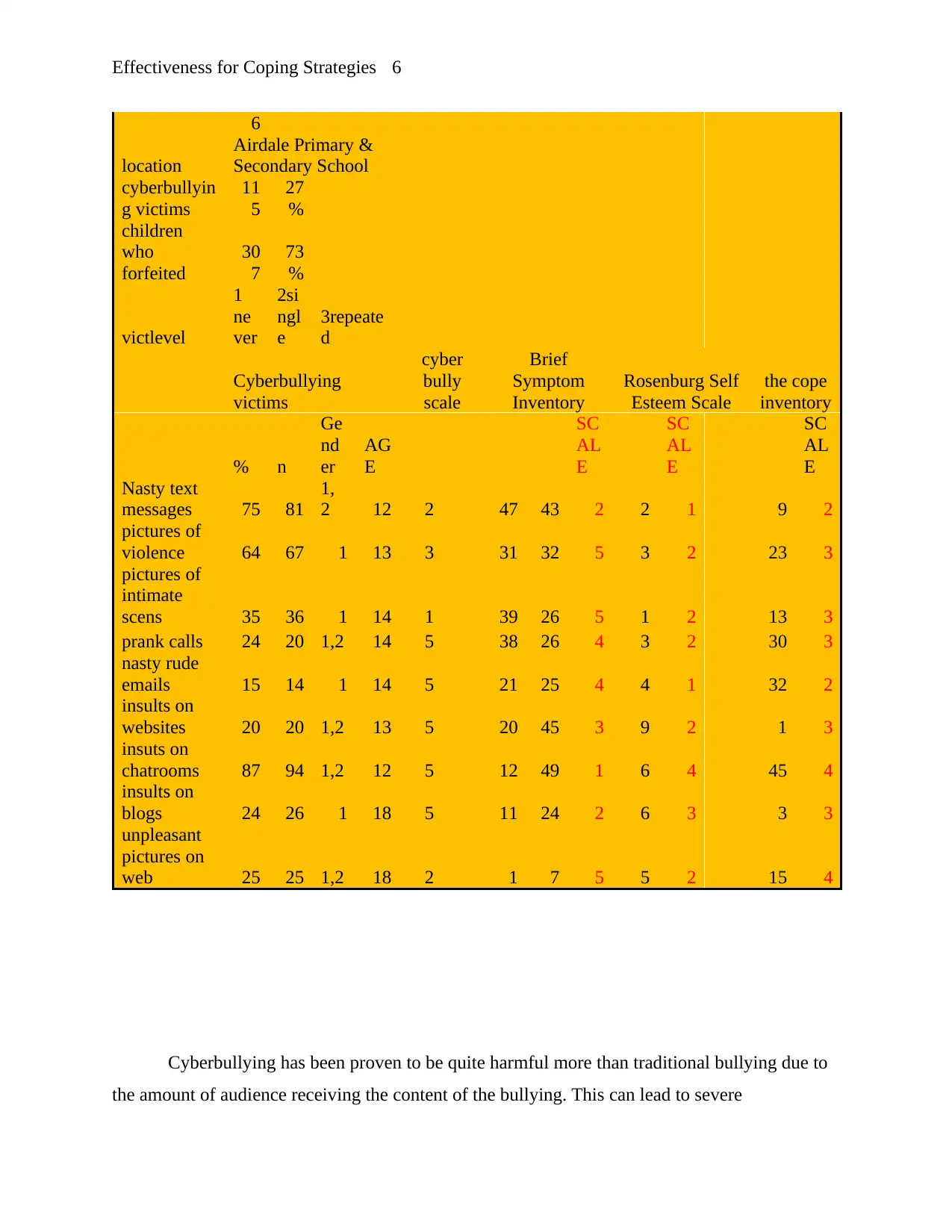
Effectiveness for Coping Strategies 6
6
location
Airdale Primary &
Secondary School
cyberbullyin
g victims
11
5
27
%
children
who
forfeited
30
7
73
%
victlevel
1
ne
ver
2si
ngl
e
3repeate
d
Cyberbullying
victims
cyber
bully
scale
Brief
Symptom
Inventory
Rosenburg Self
Esteem Scale
the cope
inventory
% n
Ge
nd
er
AG
E
SC
AL
E
SC
AL
E
SC
AL
E
Nasty text
messages 75 81
1,
2 12 2 47 43 2 2 1 9 2
pictures of
violence 64 67 1 13 3 31 32 5 3 2 23 3
pictures of
intimate
scens 35 36 1 14 1 39 26 5 1 2 13 3
prank calls 24 20 1,2 14 5 38 26 4 3 2 30 3
nasty rude
emails 15 14 1 14 5 21 25 4 4 1 32 2
insults on
websites 20 20 1,2 13 5 20 45 3 9 2 1 3
insuts on
chatrooms 87 94 1,2 12 5 12 49 1 6 4 45 4
insults on
blogs 24 26 1 18 5 11 24 2 6 3 3 3
unpleasant
pictures on
web 25 25 1,2 18 2 1 7 5 5 2 15 4
Cyberbullying has been proven to be quite harmful more than traditional bullying due to
the amount of audience receiving the content of the bullying. This can lead to severe
6
location
Airdale Primary &
Secondary School
cyberbullyin
g victims
11
5
27
%
children
who
forfeited
30
7
73
%
victlevel
1
ne
ver
2si
ngl
e
3repeate
d
Cyberbullying
victims
cyber
bully
scale
Brief
Symptom
Inventory
Rosenburg Self
Esteem Scale
the cope
inventory
% n
Ge
nd
er
AG
E
SC
AL
E
SC
AL
E
SC
AL
E
Nasty text
messages 75 81
1,
2 12 2 47 43 2 2 1 9 2
pictures of
violence 64 67 1 13 3 31 32 5 3 2 23 3
pictures of
intimate
scens 35 36 1 14 1 39 26 5 1 2 13 3
prank calls 24 20 1,2 14 5 38 26 4 3 2 30 3
nasty rude
emails 15 14 1 14 5 21 25 4 4 1 32 2
insults on
websites 20 20 1,2 13 5 20 45 3 9 2 1 3
insuts on
chatrooms 87 94 1,2 12 5 12 49 1 6 4 45 4
insults on
blogs 24 26 1 18 5 11 24 2 6 3 3 3
unpleasant
pictures on
web 25 25 1,2 18 2 1 7 5 5 2 15 4
Cyberbullying has been proven to be quite harmful more than traditional bullying due to
the amount of audience receiving the content of the bullying. This can lead to severe
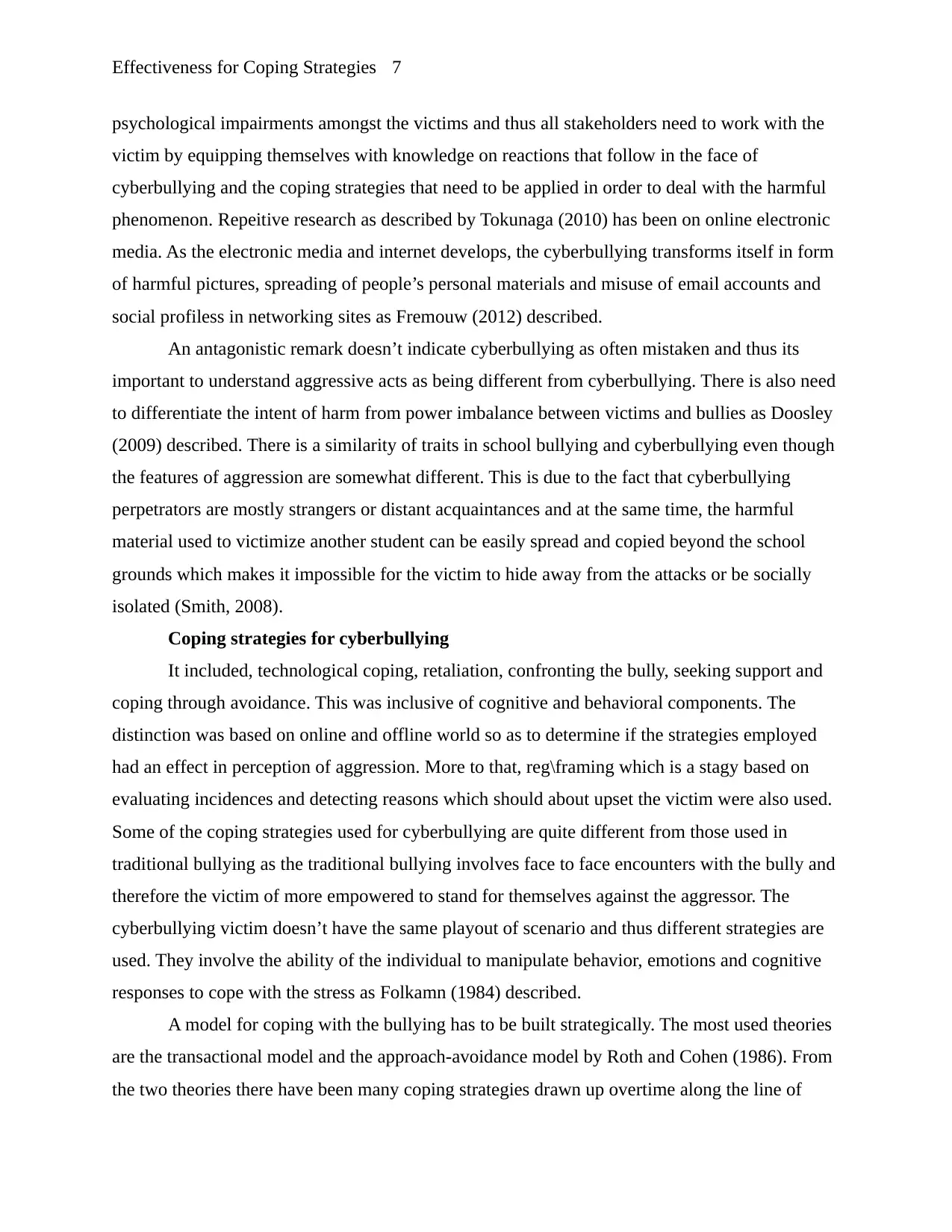
Effectiveness for Coping Strategies 7
psychological impairments amongst the victims and thus all stakeholders need to work with the
victim by equipping themselves with knowledge on reactions that follow in the face of
cyberbullying and the coping strategies that need to be applied in order to deal with the harmful
phenomenon. Repeitive research as described by Tokunaga (2010) has been on online electronic
media. As the electronic media and internet develops, the cyberbullying transforms itself in form
of harmful pictures, spreading of people’s personal materials and misuse of email accounts and
social profiless in networking sites as Fremouw (2012) described.
An antagonistic remark doesn’t indicate cyberbullying as often mistaken and thus its
important to understand aggressive acts as being different from cyberbullying. There is also need
to differentiate the intent of harm from power imbalance between victims and bullies as Doosley
(2009) described. There is a similarity of traits in school bullying and cyberbullying even though
the features of aggression are somewhat different. This is due to the fact that cyberbullying
perpetrators are mostly strangers or distant acquaintances and at the same time, the harmful
material used to victimize another student can be easily spread and copied beyond the school
grounds which makes it impossible for the victim to hide away from the attacks or be socially
isolated (Smith, 2008).
Coping strategies for cyberbullying
It included, technological coping, retaliation, confronting the bully, seeking support and
coping through avoidance. This was inclusive of cognitive and behavioral components. The
distinction was based on online and offline world so as to determine if the strategies employed
had an effect in perception of aggression. More to that, reg\framing which is a stagy based on
evaluating incidences and detecting reasons which should about upset the victim were also used.
Some of the coping strategies used for cyberbullying are quite different from those used in
traditional bullying as the traditional bullying involves face to face encounters with the bully and
therefore the victim of more empowered to stand for themselves against the aggressor. The
cyberbullying victim doesn’t have the same playout of scenario and thus different strategies are
used. They involve the ability of the individual to manipulate behavior, emotions and cognitive
responses to cope with the stress as Folkamn (1984) described.
A model for coping with the bullying has to be built strategically. The most used theories
are the transactional model and the approach-avoidance model by Roth and Cohen (1986). From
the two theories there have been many coping strategies drawn up overtime along the line of
psychological impairments amongst the victims and thus all stakeholders need to work with the
victim by equipping themselves with knowledge on reactions that follow in the face of
cyberbullying and the coping strategies that need to be applied in order to deal with the harmful
phenomenon. Repeitive research as described by Tokunaga (2010) has been on online electronic
media. As the electronic media and internet develops, the cyberbullying transforms itself in form
of harmful pictures, spreading of people’s personal materials and misuse of email accounts and
social profiless in networking sites as Fremouw (2012) described.
An antagonistic remark doesn’t indicate cyberbullying as often mistaken and thus its
important to understand aggressive acts as being different from cyberbullying. There is also need
to differentiate the intent of harm from power imbalance between victims and bullies as Doosley
(2009) described. There is a similarity of traits in school bullying and cyberbullying even though
the features of aggression are somewhat different. This is due to the fact that cyberbullying
perpetrators are mostly strangers or distant acquaintances and at the same time, the harmful
material used to victimize another student can be easily spread and copied beyond the school
grounds which makes it impossible for the victim to hide away from the attacks or be socially
isolated (Smith, 2008).
Coping strategies for cyberbullying
It included, technological coping, retaliation, confronting the bully, seeking support and
coping through avoidance. This was inclusive of cognitive and behavioral components. The
distinction was based on online and offline world so as to determine if the strategies employed
had an effect in perception of aggression. More to that, reg\framing which is a stagy based on
evaluating incidences and detecting reasons which should about upset the victim were also used.
Some of the coping strategies used for cyberbullying are quite different from those used in
traditional bullying as the traditional bullying involves face to face encounters with the bully and
therefore the victim of more empowered to stand for themselves against the aggressor. The
cyberbullying victim doesn’t have the same playout of scenario and thus different strategies are
used. They involve the ability of the individual to manipulate behavior, emotions and cognitive
responses to cope with the stress as Folkamn (1984) described.
A model for coping with the bullying has to be built strategically. The most used theories
are the transactional model and the approach-avoidance model by Roth and Cohen (1986). From
the two theories there have been many coping strategies drawn up overtime along the line of
Paraphrase This Document
Need a fresh take? Get an instant paraphrase of this document with our AI Paraphraser

Effectiveness for Coping Strategies 8
focusing on the problem or emotion. The strategy can only be forged once the data is understood
and thus being able to successful describe the coping environment or situation.
Avoidance of problems has been described as being more focused on the problem than
the emotions. In cyberbullying there needs to be availability of coping strategies which makes it
more complicated to understood. Through their engagement with students, Paris et.al (2011)
described that the ability of the students to acknowledge that inaction strategies worked between
than the problem avoidance due to the fact that the students acknowledged that aggressive online
behavior was part of their lives.
Persen et. al. (2012) suggested that response to cyberbullying be categorized as:
Targeted towards cyberbullies (retaliating)
Ignoring the aggressor (avoidant behavior)
Seeking instrumental and emotional support (from teachers, friend or external
instructors)
Use of specific technical solutions (use of report abuse buttons, blocking senders
amongst others)
Its important to understand that cyberbullying require multiple strategies due to its extent
of reach of victimization. However, all the multipurpose strategies are tailored to address specific
cyberbullying situations. More to that, coping strategies can be focused on the problem or the
emotions or abouth at the same time. Inaction is taken as a strategy of its own as it is not emotion
or problem focused.
How effective the responses to cyberbullying are?
There have been different strategies overtime that have been favored by victims as studies
have shown. Some of them were rated as the most effective strategies as Livingstone (et.al.
(2011) described. They include technical solutions which are plied overtime and evaluated
frequently. Thy have been shown to be helpful and effective. Seeking support has also been
shown to be effective regardlesss of the fact that the person sought after for support may vary.
Others have proven to work although they are less reliable and lesss effective too. One of them
includes ignoring the aggressor and doing nothing among them. This involve going to the extent
of avoiding the internet altogether.
Another key measure is to practice the nature of other measures adopted by other victims
to cope with cyberbullying which involves a problem focused strategy. Most of the measures
focusing on the problem or emotion. The strategy can only be forged once the data is understood
and thus being able to successful describe the coping environment or situation.
Avoidance of problems has been described as being more focused on the problem than
the emotions. In cyberbullying there needs to be availability of coping strategies which makes it
more complicated to understood. Through their engagement with students, Paris et.al (2011)
described that the ability of the students to acknowledge that inaction strategies worked between
than the problem avoidance due to the fact that the students acknowledged that aggressive online
behavior was part of their lives.
Persen et. al. (2012) suggested that response to cyberbullying be categorized as:
Targeted towards cyberbullies (retaliating)
Ignoring the aggressor (avoidant behavior)
Seeking instrumental and emotional support (from teachers, friend or external
instructors)
Use of specific technical solutions (use of report abuse buttons, blocking senders
amongst others)
Its important to understand that cyberbullying require multiple strategies due to its extent
of reach of victimization. However, all the multipurpose strategies are tailored to address specific
cyberbullying situations. More to that, coping strategies can be focused on the problem or the
emotions or abouth at the same time. Inaction is taken as a strategy of its own as it is not emotion
or problem focused.
How effective the responses to cyberbullying are?
There have been different strategies overtime that have been favored by victims as studies
have shown. Some of them were rated as the most effective strategies as Livingstone (et.al.
(2011) described. They include technical solutions which are plied overtime and evaluated
frequently. Thy have been shown to be helpful and effective. Seeking support has also been
shown to be effective regardlesss of the fact that the person sought after for support may vary.
Others have proven to work although they are less reliable and lesss effective too. One of them
includes ignoring the aggressor and doing nothing among them. This involve going to the extent
of avoiding the internet altogether.
Another key measure is to practice the nature of other measures adopted by other victims
to cope with cyberbullying which involves a problem focused strategy. Most of the measures
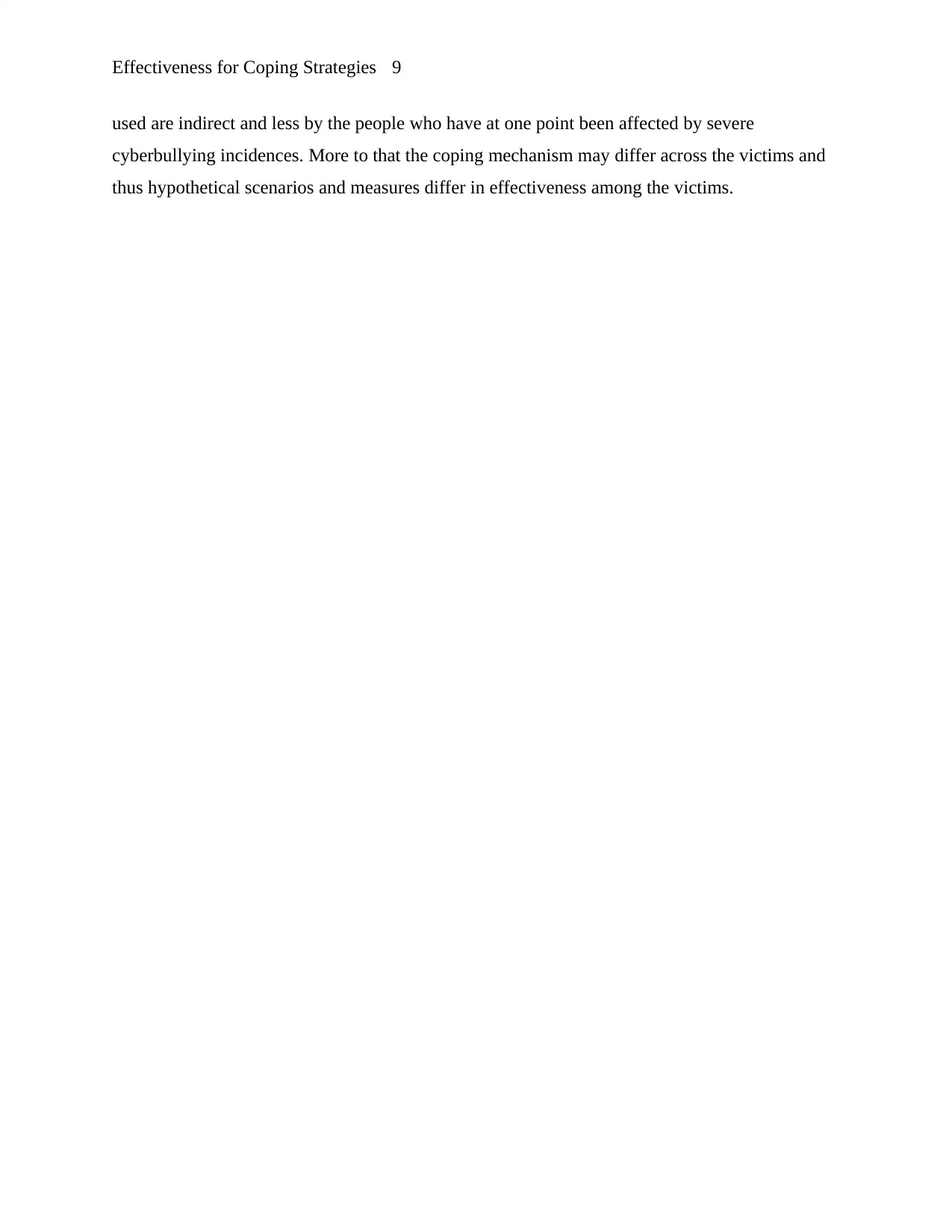
Effectiveness for Coping Strategies 9
used are indirect and less by the people who have at one point been affected by severe
cyberbullying incidences. More to that the coping mechanism may differ across the victims and
thus hypothetical scenarios and measures differ in effectiveness among the victims.
used are indirect and less by the people who have at one point been affected by severe
cyberbullying incidences. More to that the coping mechanism may differ across the victims and
thus hypothetical scenarios and measures differ in effectiveness among the victims.
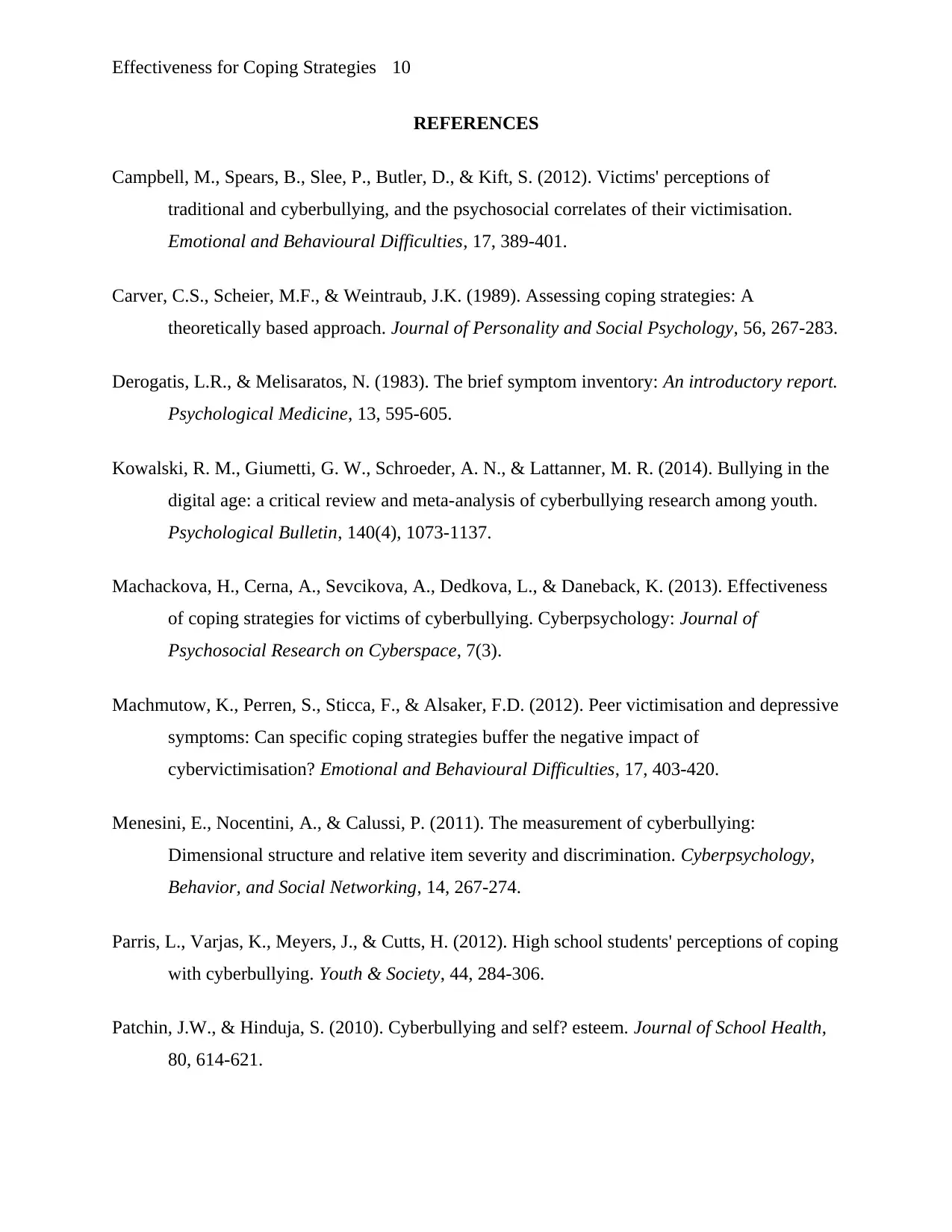
Effectiveness for Coping Strategies 10
REFERENCES
Campbell, M., Spears, B., Slee, P., Butler, D., & Kift, S. (2012). Victims' perceptions of
traditional and cyberbullying, and the psychosocial correlates of their victimisation.
Emotional and Behavioural Difficulties, 17, 389-401.
Carver, C.S., Scheier, M.F., & Weintraub, J.K. (1989). Assessing coping strategies: A
theoretically based approach. Journal of Personality and Social Psychology, 56, 267-283.
Derogatis, L.R., & Melisaratos, N. (1983). The brief symptom inventory: An introductory report.
Psychological Medicine, 13, 595-605.
Kowalski, R. M., Giumetti, G. W., Schroeder, A. N., & Lattanner, M. R. (2014). Bullying in the
digital age: a critical review and meta-analysis of cyberbullying research among youth.
Psychological Bulletin, 140(4), 1073-1137.
Machackova, H., Cerna, A., Sevcikova, A., Dedkova, L., & Daneback, K. (2013). Effectiveness
of coping strategies for victims of cyberbullying. Cyberpsychology: Journal of
Psychosocial Research on Cyberspace, 7(3).
Machmutow, K., Perren, S., Sticca, F., & Alsaker, F.D. (2012). Peer victimisation and depressive
symptoms: Can specific coping strategies buffer the negative impact of
cybervictimisation? Emotional and Behavioural Difficulties, 17, 403-420.
Menesini, E., Nocentini, A., & Calussi, P. (2011). The measurement of cyberbullying:
Dimensional structure and relative item severity and discrimination. Cyberpsychology,
Behavior, and Social Networking, 14, 267-274.
Parris, L., Varjas, K., Meyers, J., & Cutts, H. (2012). High school students' perceptions of coping
with cyberbullying. Youth & Society, 44, 284-306.
Patchin, J.W., & Hinduja, S. (2010). Cyberbullying and self? esteem. Journal of School Health,
80, 614-621.
REFERENCES
Campbell, M., Spears, B., Slee, P., Butler, D., & Kift, S. (2012). Victims' perceptions of
traditional and cyberbullying, and the psychosocial correlates of their victimisation.
Emotional and Behavioural Difficulties, 17, 389-401.
Carver, C.S., Scheier, M.F., & Weintraub, J.K. (1989). Assessing coping strategies: A
theoretically based approach. Journal of Personality and Social Psychology, 56, 267-283.
Derogatis, L.R., & Melisaratos, N. (1983). The brief symptom inventory: An introductory report.
Psychological Medicine, 13, 595-605.
Kowalski, R. M., Giumetti, G. W., Schroeder, A. N., & Lattanner, M. R. (2014). Bullying in the
digital age: a critical review and meta-analysis of cyberbullying research among youth.
Psychological Bulletin, 140(4), 1073-1137.
Machackova, H., Cerna, A., Sevcikova, A., Dedkova, L., & Daneback, K. (2013). Effectiveness
of coping strategies for victims of cyberbullying. Cyberpsychology: Journal of
Psychosocial Research on Cyberspace, 7(3).
Machmutow, K., Perren, S., Sticca, F., & Alsaker, F.D. (2012). Peer victimisation and depressive
symptoms: Can specific coping strategies buffer the negative impact of
cybervictimisation? Emotional and Behavioural Difficulties, 17, 403-420.
Menesini, E., Nocentini, A., & Calussi, P. (2011). The measurement of cyberbullying:
Dimensional structure and relative item severity and discrimination. Cyberpsychology,
Behavior, and Social Networking, 14, 267-274.
Parris, L., Varjas, K., Meyers, J., & Cutts, H. (2012). High school students' perceptions of coping
with cyberbullying. Youth & Society, 44, 284-306.
Patchin, J.W., & Hinduja, S. (2010). Cyberbullying and self? esteem. Journal of School Health,
80, 614-621.
Secure Best Marks with AI Grader
Need help grading? Try our AI Grader for instant feedback on your assignments.
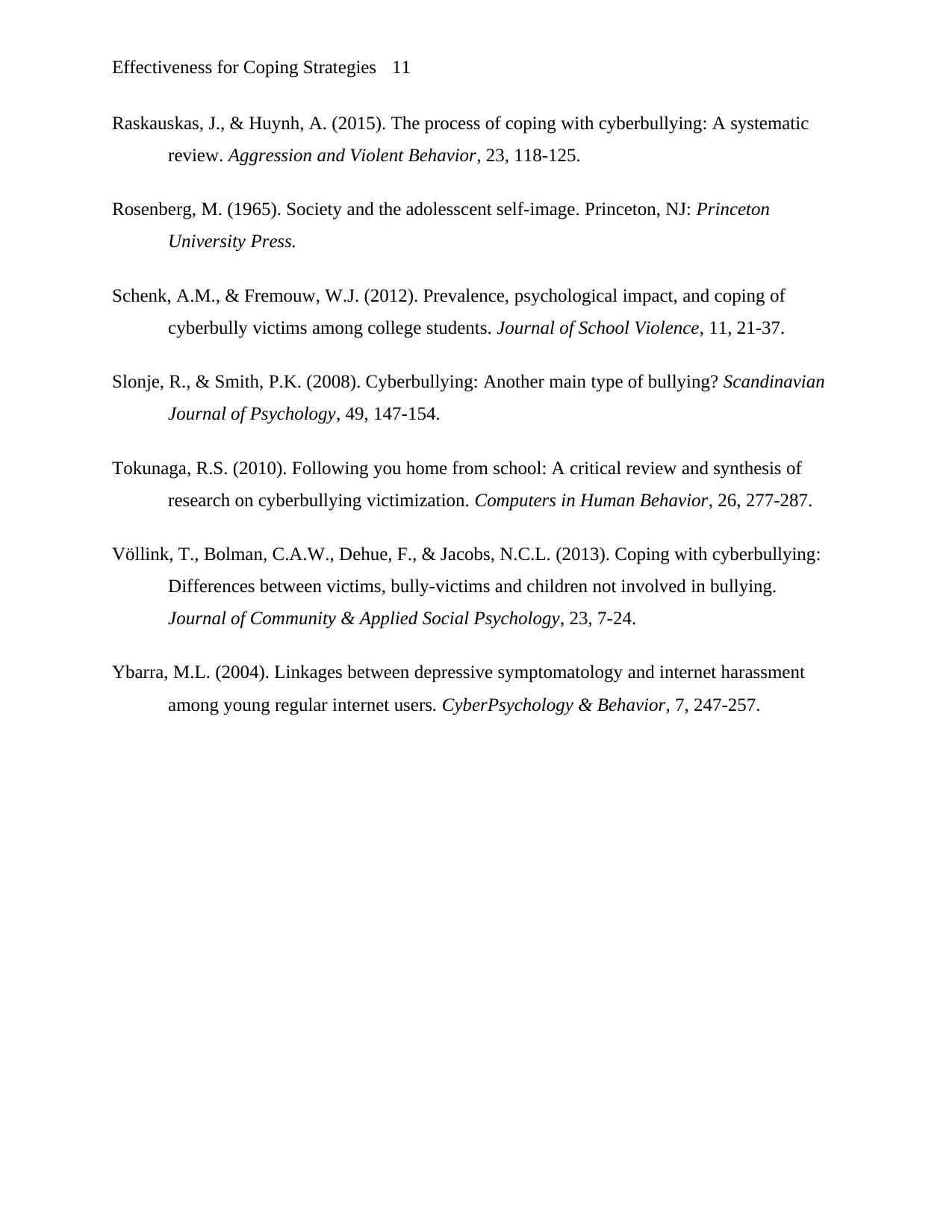
Effectiveness for Coping Strategies 11
Raskauskas, J., & Huynh, A. (2015). The process of coping with cyberbullying: A systematic
review. Aggression and Violent Behavior, 23, 118-125.
Rosenberg, M. (1965). Society and the adolesscent self-image. Princeton, NJ: Princeton
University Press.
Schenk, A.M., & Fremouw, W.J. (2012). Prevalence, psychological impact, and coping of
cyberbully victims among college students. Journal of School Violence, 11, 21-37.
Slonje, R., & Smith, P.K. (2008). Cyberbullying: Another main type of bullying? Scandinavian
Journal of Psychology, 49, 147-154.
Tokunaga, R.S. (2010). Following you home from school: A critical review and synthesis of
research on cyberbullying victimization. Computers in Human Behavior, 26, 277-287.
Völlink, T., Bolman, C.A.W., Dehue, F., & Jacobs, N.C.L. (2013). Coping with cyberbullying:
Differences between victims, bully-victims and children not involved in bullying.
Journal of Community & Applied Social Psychology, 23, 7-24.
Ybarra, M.L. (2004). Linkages between depressive symptomatology and internet harassment
among young regular internet users. CyberPsychology & Behavior, 7, 247-257.
Raskauskas, J., & Huynh, A. (2015). The process of coping with cyberbullying: A systematic
review. Aggression and Violent Behavior, 23, 118-125.
Rosenberg, M. (1965). Society and the adolesscent self-image. Princeton, NJ: Princeton
University Press.
Schenk, A.M., & Fremouw, W.J. (2012). Prevalence, psychological impact, and coping of
cyberbully victims among college students. Journal of School Violence, 11, 21-37.
Slonje, R., & Smith, P.K. (2008). Cyberbullying: Another main type of bullying? Scandinavian
Journal of Psychology, 49, 147-154.
Tokunaga, R.S. (2010). Following you home from school: A critical review and synthesis of
research on cyberbullying victimization. Computers in Human Behavior, 26, 277-287.
Völlink, T., Bolman, C.A.W., Dehue, F., & Jacobs, N.C.L. (2013). Coping with cyberbullying:
Differences between victims, bully-victims and children not involved in bullying.
Journal of Community & Applied Social Psychology, 23, 7-24.
Ybarra, M.L. (2004). Linkages between depressive symptomatology and internet harassment
among young regular internet users. CyberPsychology & Behavior, 7, 247-257.
1 out of 11
Related Documents
Your All-in-One AI-Powered Toolkit for Academic Success.
+13062052269
info@desklib.com
Available 24*7 on WhatsApp / Email
![[object Object]](/_next/static/media/star-bottom.7253800d.svg)
Unlock your academic potential
© 2024 | Zucol Services PVT LTD | All rights reserved.





